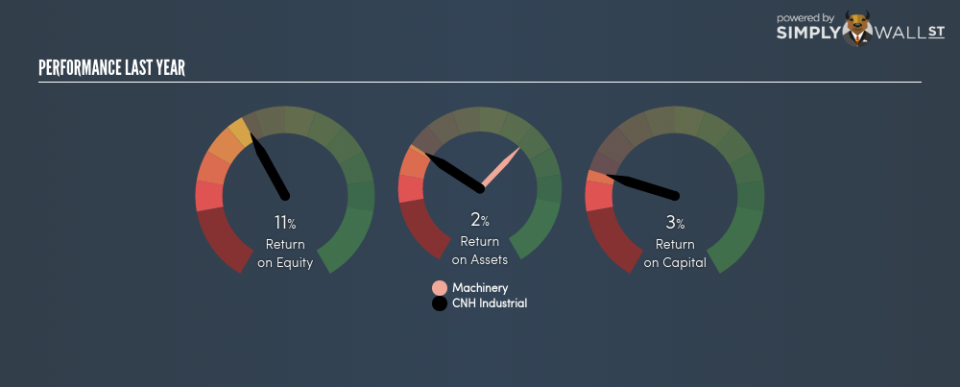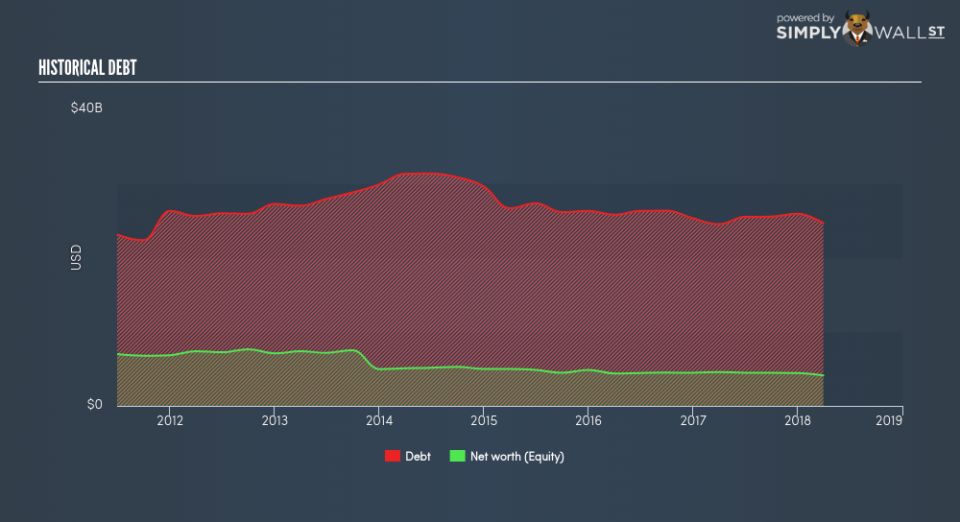Should You Expect CNH Industrial NV (NYSE:CNHI) To Continue Delivering An ROE Of 11.38%?

The content of this article will benefit those of you who are starting to educate yourself about investing in the stock market and want a simplistic look at the return on CNH Industrial NV (NYSE:CNHI) stock.
With an ROE of 11.38%, CNH Industrial NV (NYSE:CNHI) outpaced its own industry which delivered a less exciting 11.36% over the past year. On the surface, this looks fantastic since we know that CNHI has made large profits from little equity capital; however, ROE doesn’t tell us if management have borrowed heavily to make this happen. Today, we’ll take a closer look at some factors like financial leverage to see how sustainable CNHI’s ROE is. Check out our latest analysis for CNH Industrial
What you must know about ROE
Firstly, Return on Equity, or ROE, is simply the percentage of last years’ earning against the book value of shareholders’ equity. For example, if the company invests $1 in the form of equity, it will generate $0.11 in earnings from this. Generally speaking, a higher ROE is preferred; however, there are other factors we must also consider before making any conclusions.
Return on Equity = Net Profit ÷ Shareholders Equity
ROE is assessed against cost of equity, which is measured using the Capital Asset Pricing Model (CAPM) – but let’s not dive into the details of that today. For now, let’s just look at the cost of equity number for CNH Industrial, which is 17.05%. Since CNH Industrial’s return does not cover its cost, with a difference of -5.67%, this means its current use of equity is not efficient and not sustainable. Very simply, CNH Industrial pays more for its capital than what it generates in return. ROE can be split up into three useful ratios: net profit margin, asset turnover, and financial leverage. This is called the Dupont Formula:
Dupont Formula
ROE = profit margin × asset turnover × financial leverage
ROE = (annual net profit ÷ sales) × (sales ÷ assets) × (assets ÷ shareholders’ equity)
ROE = annual net profit ÷ shareholders’ equity
Essentially, profit margin shows how much money the company makes after paying for all its expenses. Asset turnover reveals how much revenue can be generated from CNH Industrial’s asset base. The most interesting ratio, and reflective of sustainability of its ROE, is financial leverage. Since ROE can be artificially increased through excessive borrowing, we should check CNH Industrial’s historic debt-to-equity ratio. The debt-to-equity ratio currently stands at over 2.5 times, meaning the above-average ratio is a result of a large amount of debt.
Next Steps:
ROE is a simple yet informative ratio, illustrating the various components that each measure the quality of the overall stock. CNH Industrial’s ROE is impressive relative to the industry average, though its returns were not strong enough to cover its own cost of equity. Its debt level is above equity which means its above-industry ROE may be driven by debt funding which raises concerns over the sustainability of CNH Industrial’s returns. Although ROE can be a useful metric, it is only a small part of diligent research.
For CNH Industrial, I’ve compiled three essential factors you should look at:
Financial Health: Does it have a healthy balance sheet? Take a look at our free balance sheet analysis with six simple checks on key factors like leverage and risk.
Valuation: What is CNH Industrial worth today? Is the stock undervalued, even when its growth outlook is factored into its intrinsic value? The intrinsic value infographic in our free research report helps visualize whether CNH Industrial is currently mispriced by the market.
Other High-Growth Alternatives : Are there other high-growth stocks you could be holding instead of CNH Industrial? Explore our interactive list of stocks with large growth potential to get an idea of what else is out there you may be missing!
To help readers see pass the short term volatility of the financial market, we aim to bring you a long-term focused research analysis purely driven by fundamental data. Note that our analysis does not factor in the latest price sensitive company announcements.
The author is an independent contributor and at the time of publication had no position in the stocks mentioned.

 Yahoo Finance
Yahoo Finance 

